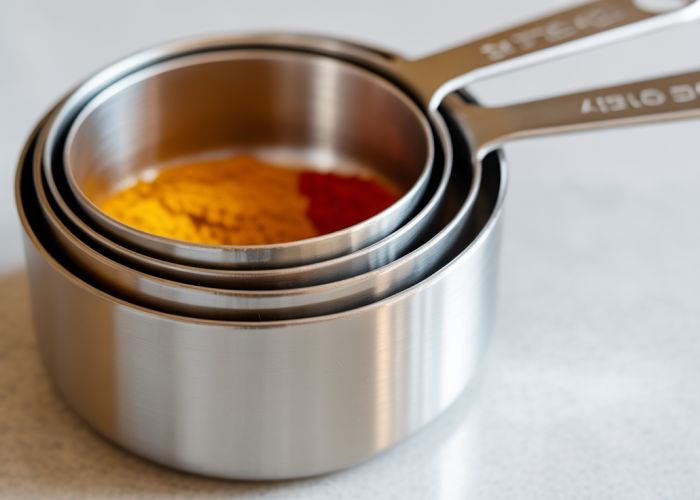The cup measure for kitchen is an essential tool, playing a crucial role in precision and consistency. Stainless steel, a durable material, ensures longevity for your measuring tools, making them a worthwhile investment for any baker. Understanding the different types of cup measures, from dry to liquid, is key to successful recipes; each is designed for optimal accuracy. For consistent results, consider the advice of seasoned chefs, who often emphasize using leveled measurements to avoid inaccuracies. Choosing the right cup measure for kitchen impacts everything from baking to cooking, so take the time to select quality tools.

Understanding the Best Cup Measure for Your Kitchen
Choosing the right "cup measure for kitchen" can significantly improve your cooking and baking accuracy. There’s more to it than just grabbing the first set you see. This guide will walk you through the different types, materials, and considerations to help you pick the best ones for your needs.
Different Types of Cup Measures
There are two primary types of cup measures: dry measuring cups and liquid measuring cups. Using the wrong type can impact your recipe results.
Dry Measuring Cups
- Purpose: Designed for measuring dry ingredients like flour, sugar, and oats.
- Features: Usually made of rigid materials like metal or plastic.
- Appearance: Typically come in sets with common measurements like 1 cup, ½ cup, ⅓ cup, and ¼ cup.
- How to Use: Overfill the cup, then level off the excess using a straight-edged tool like a knife or the back of a spatula. This ensures consistent measurements.
Liquid Measuring Cups
- Purpose: Designed for measuring liquids like water, milk, or oil.
- Features: Usually made of clear glass or plastic with measurement markings on the side.
- Appearance: Often have a pouring spout for easy transfer.
- How to Use: Place the cup on a flat surface and fill it to the desired measurement line, checking at eye level to ensure accuracy. Avoid filling above the line.
Materials Matter: Cup Measure Materials and Their Properties
The material of your "cup measure for kitchen" affects its durability, ease of cleaning, and sometimes, even its accuracy.
Plastic Measuring Cups
- Pros: Lightweight, inexpensive, often dishwasher-safe.
- Cons: Can stain or warp over time, may not be as durable as other materials.
- Ideal For: General everyday cooking and baking.
Metal Measuring Cups
- Pros: Durable, long-lasting, resistant to staining, often dishwasher-safe.
- Cons: Can be more expensive than plastic, may get hot when measuring hot ingredients.
- Ideal For: Heavy-duty use, professional kitchens, cooks who value durability.
Glass Measuring Cups (Liquid Only)
- Pros: Accurate, easy to read, oven-safe (check manufacturer’s instructions), dishwasher-safe.
- Cons: Can be breakable, heavier than plastic.
- Ideal For: Measuring liquids that need to be heated or microwaved.
Silicone Measuring Cups
- Pros: Flexible, heat-resistant, easy to clean, often collapsible for storage.
- Cons: May not be as rigid as other materials, can be pricier.
- Ideal For: Measuring sticky ingredients, reducing storage space.
Considerations When Choosing Your "Cup Measure for Kitchen"
Beyond the type and material, consider these factors to find the best "cup measure for kitchen" set for your needs:
- Measurement Markings: Look for clear, easy-to-read markings that won’t fade over time. Embossed or etched markings are generally more durable than printed ones.
- Handle Design: Choose cups with comfortable and sturdy handles that provide a good grip, especially for liquid measures.
- Storage: Consider how you’ll store your measuring cups. Stackable sets or those that nest together save space.
- Set Completeness: Ensure the set includes the most common measurements you’ll need, such as 1 cup, ½ cup, ⅓ cup, ¼ cup, and tablespoons/teaspoons. Individual cup measures are also available, so you can purchase specific sizes that are missing from existing sets.
Measurement Conversions (Table)
Sometimes a recipe calls for measurements you don’t have a cup measure for. Here’s a handy conversion table:
| Measurement | Equivalent in Cups |
|---|---|
| 1 Tablespoon (tbsp) | 1/16 cup |
| 2 Tablespoons (tbsp) | 1/8 cup |
| 4 Tablespoons (tbsp) | 1/4 cup |
| 8 Tablespoons (tbsp) | 1/2 cup |
| 16 Tablespoons (tbsp) | 1 cup |
FAQs About Choosing the Right Cup Measure for Your Kitchen
Here are some frequently asked questions to help you choose the perfect cup measures for your kitchen and baking needs.
What’s the difference between liquid and dry cup measures?
Liquid cup measures are typically clear, with a spout and markings on the side for easy pouring and accurate measurement of liquids. Dry cup measures are designed to be filled to the top and leveled off for accurate measurement of dry ingredients. It’s important to use the right type of cup measure for kitchen success!
Why is accuracy so important when using a cup measure for kitchen recipes?
Accuracy is key, especially in baking! Small differences in measurements can drastically affect the outcome of your recipe. Using the correct cup measure ensures the right ingredient ratios for perfect results.
Should I choose stainless steel or plastic cup measures for my kitchen?
Both stainless steel and plastic cup measures are viable options. Stainless steel is durable and won’t stain, but can be more expensive. Plastic is more affordable and lightweight, but may stain or warp over time. Consider your budget and needs when deciding.
How should I properly clean and store my cup measures?
Most cup measures are dishwasher safe, but hand washing can extend their lifespan. Make sure to dry them thoroughly before storing to prevent rust or mold. Nesting cup measures are ideal for saving space in your kitchen.
Alright, now you’re all set to conquer the kitchen with the perfect cup measure for kitchen! Happy cooking, and remember, a little precision goes a long way. Enjoy!



